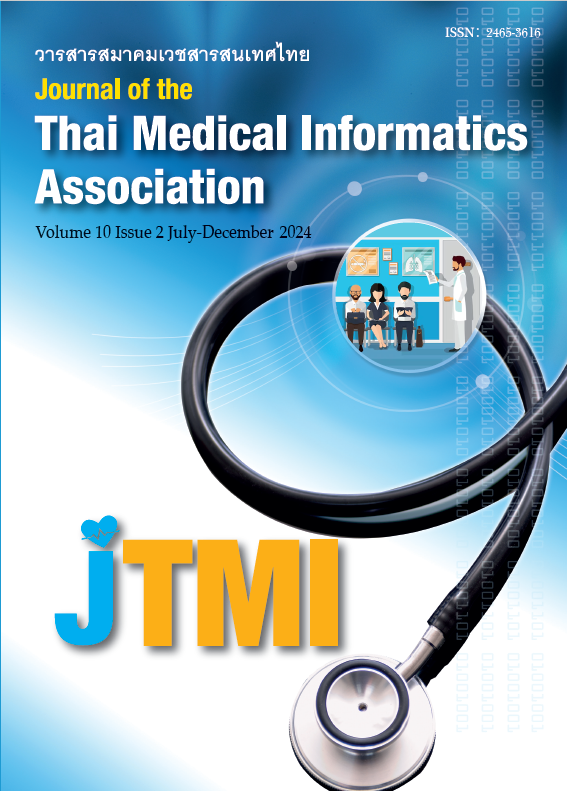The development of the non – drug pharmaceutical management system at Priest Hospital
Keywords:
Non – drug pharmaceutical management system, Inventory managementAbstract
Efficient non-drug pharmaceutical management within a hospital is crucial for various reasons. Firstly, it aims to reduce expenses in the procurement of medications. Secondly, it involves managing pharmaceuticals adequately to ensure sufficient supplies for patient care, thereby optimizing treatment outcomes and preventing excessive stockpiling that could lead to medication expiry without utilization. The efficient management of pharmaceuticals contributes to cost reduction for both the hospital and patients, enhancing the overall quality of healthcare services.Objectives: The primary objectives are to decrease hospital expenses in pharmaceutical procurement and reduce the withdrawal of medications by individual departments.Research Methodology: The study employed a descriptive research design.Results: The value of non-drug pharmaceutical withdrawals decreased significantly. Research Conclusion: Effective internal inventory management within the hospital can indeed lead to a substantial reduction in the value of non-drug pharmaceutical withdrawals.
References
ศิริพร จันทร์หอม, “การศึกษาการเพิ่มประสิทธิภาพ ในการจัดซื้อเวชภัณฑ์ โดยการนำแนวคิดระบบการ ผลิตแบบลีนมาประยุกต์ใช้ กรณศึกษา การจัดซื้อเวชภัณฑ์ ลักษณะฝากขาย โรงพยาบาลธรรมศาสตร์เฉลิมพระเกียรติ,” มหาวิทยาลัยเทคโนโลยีราชมงคลธัญบุรี, 2562.
สิริวรรณ ด้วงพูล, “การปรับปรุงระบบบริหารคลังสินค้า โดยใช้แนวคิดการบริหารคลังสินค้าโดยผู้ขาย : กรณีศึกษา โรงพยาบาลแห่งหนึ่งในจังหวัดเพชรบูรณ์,” มหาวิทยาลัย ศิลปากร, Apr. 2559.
ชนม์ชนกต์ ยงกุลวณิชนันท์, “การพัฒนาระบบบริหาร เวชภัณฑ์ในโรงพยาบาลส่งเสริมสุขภาพตำบล เขตพื้นที่ เครือข่ายหน่วยบริการปฐมภูมิอำเภอศรีเมืองใหม่ จังหวัด อุบลราชธานี,” Journal of Community Public Health, vol. 2, Apr. 2023.
D. M. S. P. H. (UK) Ahsan Siddiqui, “The Importance of Just in Time (JIT) Methodology and its Advantages in Health Care Quality Management Business – A Scoping Review,” Biomed J Sci Tech Res, vol. 42, pp. 33317–3332542, Feb. 2022.
Kelle, J. Woosley, and H. Schneider, “Pharma ceutical supply chain specifics and inventory solutions for a hospital case,” Oper Res Health Care, vol. 1, no. 2, pp. 54–63, 2012, doi: https:// doi.org/10.1016/j.orhc.2012.07.001.
D. Zepeda, G. N. Nyaga, and G. J. Young, “Supply chain risk management and hospital inventory: Effects of system affiliation,” Journal of Operations Management, vol. 44, pp. 30–47, 2016, doi: https:// doi.org/10.1016/j.jom.2016.04.002.
V Neve and C. P. Schmidt, “Point-of-use hospital inventory management with inaccurate usage capture,” Health Care Manag Sci, vol. 25, no. 1, pp. 126–145, 2022, doi: 10.1007/s10729-021-09573-1.
B. Flynn, B. Huo, and X. Zhao, “The impact of supply chain integration on performance: A contin gency and configuration approach,” Journal of Operations Management, vol. 28, no. 1, pp. 58–71, 2010, doi: https://doi.org/10.1016/j.jom.2009.06.001.
Saha and P. K. Ray, “Modelling and analysis of inventory management systems in healthcare: A review and reflections,” Comput Ind Eng, vol. 137, p. 106051, 2019, doi: https://doi.org/10.1016/j.cie.2019.106051.
Aptel and H. Pourjalali, “Improving activities and decreasing costs of logistics in hospitals: a compar ison of U.S. and French hospitals,” The International Journal of Accounting, vol. 36, no. 1, pp. 65–90, 2001, doi: https://doi.org/10.1016/S0020-7063(01) 00086-3.
Balkhi, A. Alshahrani, and A. Khan, “Just-in-time approach in healthcare inventory management: Does it really work?,” Saudi Pharmaceutical Journal, vol. 30, no. 12, pp. 1830–1835, 2022, doi: https:// doi.org/10.1016/j.jsps.2022.10.013.
S. Roni, M. Jin, and S. D. Eksioglu, “A hybrid inventory management system responding to regular demand and surge demand,” Omega (Westport), vol. 52, pp. 190–200, 2015, doi: https://doi. org/10.1016/j.omega.2014.05.002.
S. Zhou and T. L. Olsen, “Inventory rotation of medical supplies for emergency response,” Eur J Oper Res, vol. 257, no. 3, pp. 810–821, 2017, doi: https://doi.org/10.1016/j.ejor.2016.08.010.
Niakan and M. Rahimi, “A multi-objective health care inventory routing problem; a fuzzy possibilis tic approach,” Transp Res E Logist Transp Rev, vol. 80, pp. 74–94, 2015, doi: https://doi. org/10.1016/j.tre.2015.04.010.
de Vries, “The shaping of inventory systems in health services: A stakeholder analysis,” Int J Prod Econ, vol. 133, no. 1, pp. 60–69, 2011, doi: https:// doi.org/10.1016/j.ijpe.2009.10.029.
Aptel and H. Pourjalali, “Improving activities and decreasing costs of logistics in hospitals: a compar ison of U.S. and French hospitals,” The International Journal of Accounting, vol. 36, no. 1, pp. 65–90, 2001, doi: https://doi.org/10.1016/S0020-7063(01) 00086-3.
Nananukool, “Improvement of Medical Inventory Management System Under “Single Archive” Approach in Petchaburi Province - การดำเนินการ พัฒนาระบบบริหารเวชภัณฑ์ ภายใต้แนวคิด ‘คลังเดียว ราคาเดียว’ จังหวัดเพชรบุรี”, J Health Sci, vol. 24, no. 1, pp. 110–123, Nov. 2017.
ประพฤติดี ม.,“การพัฒนางานบริหารเวชภัณฑ์ใน โรงพยาบาลส่งเสริมสุขภาพตำบล อำเภอพระพรหม จังหวัดนครศรีธรรมราช”, J Health Sci Ped, ปี 1, ฉบับที่ 2, น. 16–29, เม.ย. 2021.
Sirisrisornchai, “The Characteristics of Hospital Logistics in Thailand”, J Thai Med Inform Assoc, vol. 8, no. 2, pp. 86–92, Oct. 2022.
Chanamool, T. Sangthong, and S. Kumban, “Disbursement Management of Hospital Medical Supplies with Kanban System”, IENJ, vol. 7, no. 2, pp. 41–50, Dec. 2021.
เหล่าเขตการณ์ ฉ. and วังฆนานนท์ ว., “ตัวแบบเชิง สาเหตุของการบูรณาการโซ่อุปทาน ที่มีต่อคุณภาพ การบริการของโรงพยาบาล ในสังกัดสำนักปลัดกระทรวง สาธารณสุข”, JHS.TRU, vol. 12, no. 28, pp. 124–137, May 2018.






